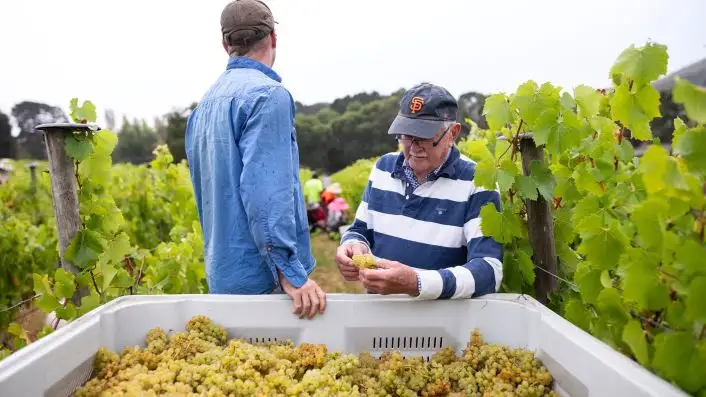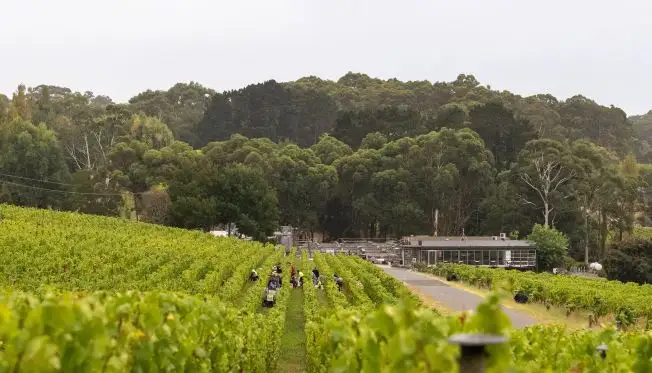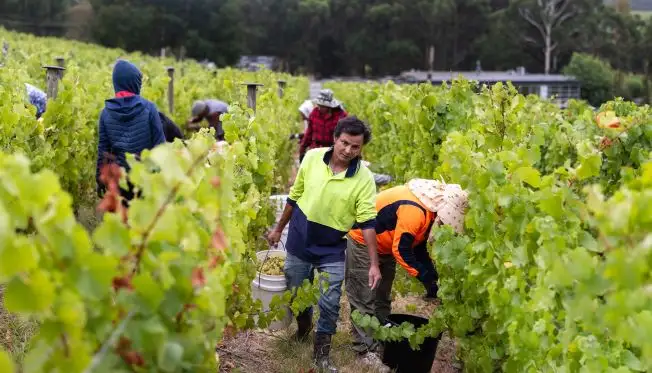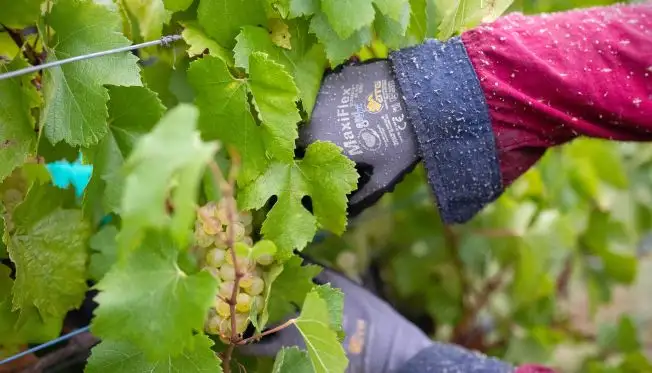
Brian Croser sends a first-hand report from Tapanappa in the Piccadilly Valley on a small but promising harvest. Above, Croser scrutinizes the Chardonnay grapes in the Tiers Vineyard.
We all know what comes in small packages, but can they be a little bigger than the 2024 vintage from our Tiers, Piccadilly Valley and Foggy Hill Fleurieu Peninsula vineyards?
At the beginning of the growing season, we anticipated harvesting 30 tonnes of Chardonnay from the Tiers Vineyard. We picked 16 tonnes on 14 March.
Similarly, we anticipated harvesting 30 tonnes of Pinot Noir from our Foggy Hill Vineyard. We picked 6 tonnes on 8 March.
In 2024 we planned to make wine from 550 tonnes of grapes at the Tapanappa Winery in the Piccadilly Valley. We received 250 tonnes of grapes from the total 2024 harvest. Only the Whalebone Vineyard in Wrattonbully, three hours south of Piccadilly and the Fleurieu, yielded a close to average crop.

What went wrong at the Tiers (shown above) and Foggy Hill?
After a slightly early budburst in early September, vine growth was normal before flowering at the end of November. The winter rains had been slightly above average and the soils were nicely full of water to support early growth.
Just as flowering started, the south-easterly winds began to blow persistently and with moderate strength. These cold winds were generated in the low latitudes of the Great Southern Ocean, bringing up cold air from the fringes of Antarctica to the top edge of expansive high-pressure systems, sweeping counterclockwise along the southern coastline of Australia. These high-pressure systems were centred on the latitude of Tasmania, reflecting a positive SAM (Southern Annular Modulation), and are usually further north in the spring.
SAM was positive because the enormous column of air spinning over the South Pole into the stratosphere (the Antarctic vortex) was very strong, sucking the high-pressure systems south.

The cold, strong south-easterly winds whistling across the coastal vineyards had a dire effect on the flowering process of the vines from 21 November into mid December.
The flowering period that is normally over in a week to 10 days extended for three weeks in a process painful to watch. It also rained intermittently throughout flowering and the caps that should fall off the opening flowers instead stuck to the pollen-bearing flower anthers, limiting the amount of pollen to reach the stigma, the doorway to the ovary. For the pollen that made it that far, the pollen tube growth from the stigma to the ovary was very slow because of the low temperatures and the pollen simply ran out of fuel before reaching its destination, the ovule or egg. Without pollination the ovule did not turn into a seed and without seeds the berries don’t develop – either at all or into very small ‘chickens’ (seedless berries).
The small percentage of fully pollinated flowers grew into normal berries with a complement of 1–4 seeds. They are the hens of the ‘hen and chicken’ syndrome more properly called millerandage. The unfertilised berries that simply fell off the bunch are the victims of coulure.

The frustrating aspect of poor flowering in 2024 is that the positive SAM has delivered a mild, even cool, growing season as it had for the previous four vintages starting with 2020. The quality of cool, dry vintages is high, creating intense but delicate grape flavours, bright colours for reds and lively natural acids to balance moderate alcohol levels.
And indeed 2024 has been cool, at average degree-day summations up to the end of March. February and March have been completely devoid of rain, so, accelerated by the low crops and a warm March, harvest was completed in perfect autumn weather in mid March exactly one month earlier than the very cool 2023 harvest.
The implications of a very small vintage are profound.
The vineyard costs as much to run with a small, average or large crop. For Foggy Hill the cost/tonne of the 6 tonnes of Pinot Noir in 2024 will be five times that for a normal crop. For Tiers Vineyard the cost/tonne of the 16 tonnes of Chardonnay will be double that of a normal crop.
In the winery the great majority of the costs remain the same, be it a small crop or big crop, so the processing costs per litre of wine made in 2024 vintage will be double a normal year.
I do not wish to explore these depressing arithmetic facts any further
Far from being a whinge about the bad luck of a poor flowering season by a disgruntled vigneron, my explanations of the 2024 vintage are made in a spirit of resignation and acceptance of the endless array of the random behaviours of Mother Nature. She always surprises. My preoccupation now is on the outstanding quality of the 2024 vintage and protecting and enhancing that in the winery.
2024 vintage certainly comes in a small package but it will be worth seeking out.
All photos by Ben Macmahon courtesy Tapanappa.

